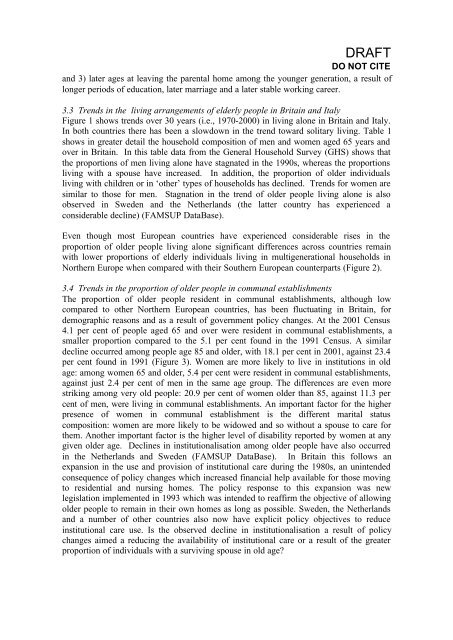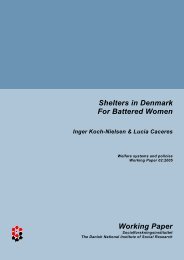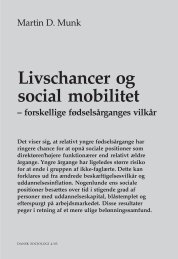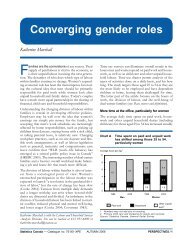Living Arrangements and Care Receipt Among Older People - SFI
Living Arrangements and Care Receipt Among Older People - SFI
Living Arrangements and Care Receipt Among Older People - SFI
Create successful ePaper yourself
Turn your PDF publications into a flip-book with our unique Google optimized e-Paper software.
DRAFT<br />
DO NOT CITE<br />
<strong>and</strong> 3) later ages at leaving the parental home among the younger generation, a result of<br />
longer periods of education, later marriage <strong>and</strong> a later stable working career.<br />
3.3 Trends in the living arrangements of elderly people in Britain <strong>and</strong> Italy<br />
Figure 1 shows trends over 30 years (i.e., 1970-2000) in living alone in Britain <strong>and</strong> Italy.<br />
In both countries there has been a slowdown in the trend toward solitary living. Table 1<br />
shows in greater detail the household composition of men <strong>and</strong> women aged 65 years <strong>and</strong><br />
over in Britain. In this table data from the General Household Survey (GHS) shows that<br />
the proportions of men living alone have stagnated in the 1990s, whereas the proportions<br />
living with a spouse have increased. In addition, the proportion of older individuals<br />
living with children or in ‘other’ types of households has declined. Trends for women are<br />
similar to those for men. Stagnation in the trend of older people living alone is also<br />
observed in Sweden <strong>and</strong> the Netherl<strong>and</strong>s (the latter country has experienced a<br />
considerable decline) (FAMSUP DataBase).<br />
Even though most European countries have experienced considerable rises in the<br />
proportion of older people living alone significant differences across countries remain<br />
with lower proportions of elderly individuals living in multigenerational households in<br />
Northern Europe when compared with their Southern European counterparts (Figure 2).<br />
3.4 Trends in the proportion of older people in communal establishments<br />
The proportion of older people resident in communal establishments, although low<br />
compared to other Northern European countries, has been fluctuating in Britain, for<br />
demographic reasons <strong>and</strong> as a result of government policy changes. At the 2001 Census<br />
4.1 per cent of people aged 65 <strong>and</strong> over were resident in communal establishments, a<br />
smaller proportion compared to the 5.1 per cent found in the 1991 Census. A similar<br />
decline occurred among people age 85 <strong>and</strong> older, with 18.1 per cent in 2001, against 23.4<br />
per cent found in 1991 (Figure 3). Women are more likely to live in institutions in old<br />
age: among women 65 <strong>and</strong> older, 5.4 per cent were resident in communal establishments,<br />
against just 2.4 per cent of men in the same age group. The differences are even more<br />
striking among very old people: 20.9 per cent of women older than 85, against 11.3 per<br />
cent of men, were living in communal establishments. An important factor for the higher<br />
presence of women in communal establishment is the different marital status<br />
composition: women are more likely to be widowed <strong>and</strong> so without a spouse to care for<br />
them. Another important factor is the higher level of disability reported by women at any<br />
given older age. Declines in institutionalisation among older people have also occurred<br />
in the Netherl<strong>and</strong>s <strong>and</strong> Sweden (FAMSUP DataBase). In Britain this follows an<br />
expansion in the use <strong>and</strong> provision of institutional care during the 1980s, an unintended<br />
consequence of policy changes which increased financial help available for those moving<br />
to residential <strong>and</strong> nursing homes. The policy response to this expansion was new<br />
legislation implemented in 1993 which was intended to reaffirm the objective of allowing<br />
older people to remain in their own homes as long as possible. Sweden, the Netherl<strong>and</strong>s<br />
<strong>and</strong> a number of other countries also now have explicit policy objectives to reduce<br />
institutional care use. Is the observed decline in institutionalisation a result of policy<br />
changes aimed a reducing the availability of institutional care or a result of the greater<br />
proportion of individuals with a surviving spouse in old age?
















